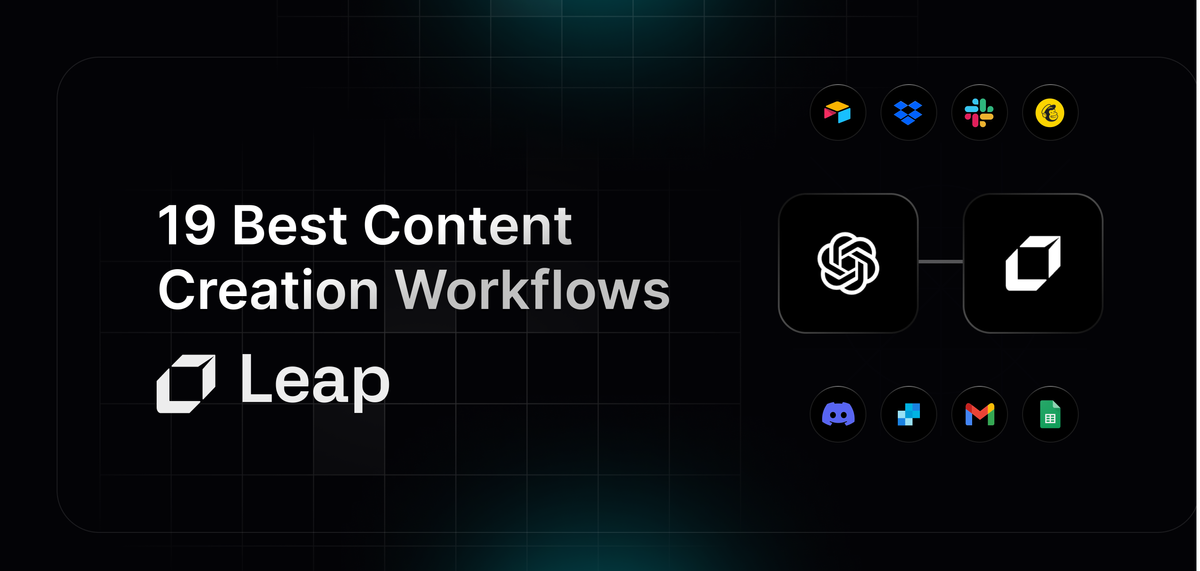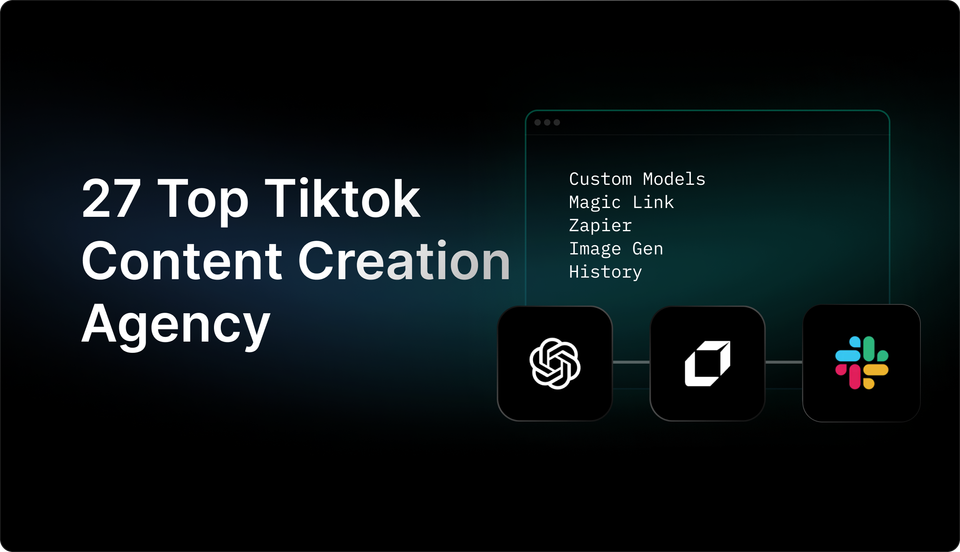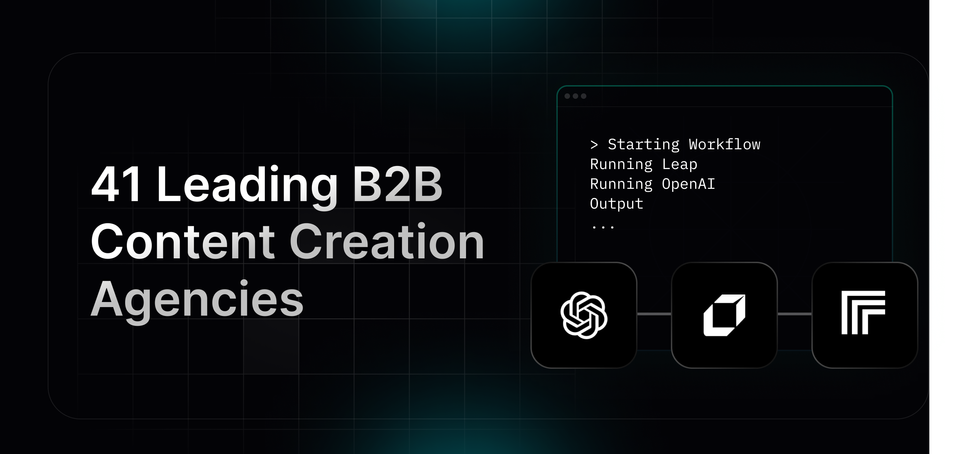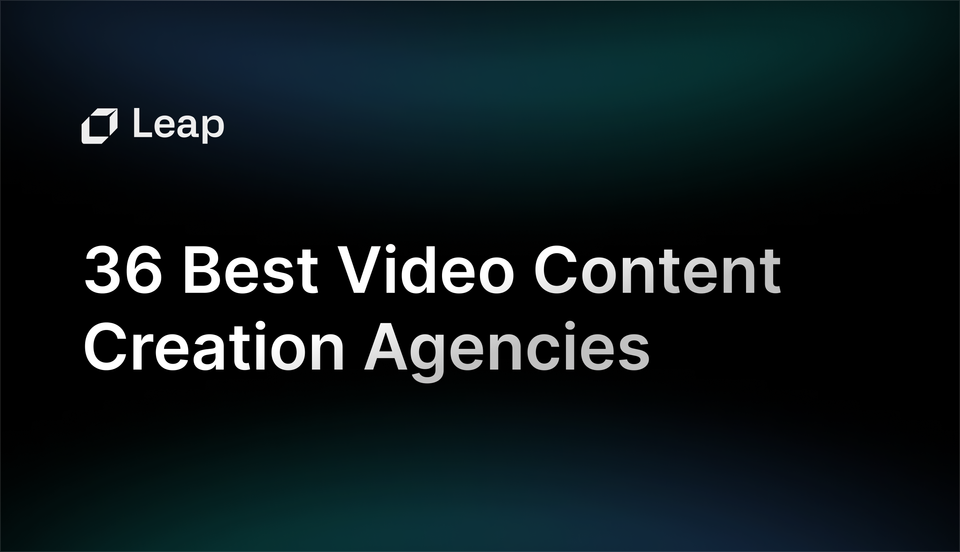19 Best Content Creation Workflows & Free AI Workflows Tool
Optimize content creation workflow effortlessly. Streamline processes for efficient, high-quality output. Elevate your creative journey now!

Creating high-quality content is not just about talent and creativity; it requires a well-structured Content Creation Workflow that ensures efficiency and effectiveness. From ideation to publication, each step in the Content Creation Workflow plays a crucial role in producing engaging and valuable content. Whether you're a writer, designer, or marketer, understanding this process is essential for achieving success in the world of content creation.
In this blog, we will delve into the intricacies of Content Creation Workflow, exploring strategies, tools, and best practices that will help you streamline your content creation process and produce exceptional content that resonates with your audience. So, let's dive in and unlock the secrets to mastering Content Creation!

What Is A Content Creation Workflow?

Content creation workflow is the systematic process of creating and managing content from start to finish. It encompasses all the steps and tasks involved in ideating, creating, editing, reviewing, and publishing content. A well-defined workflow ensures that content is produced efficiently, consistently, and meets the desired quality standards.
Content Creation Workflow in Action
To understand content creation workflow, let's walk through a typical example. Imagine you're the content manager of a fashion blog, and you're tasked with creating a new article.
1. Ideation and Planning
You start by brainstorming ideas and conducting research to identify relevant topics and trends. Once you have a list of potential topics, you prioritize them based on your editorial strategy and the interests of your target audience.
2. Content Creation
After selecting a topic, you begin the writing process. This involves outlining the article, conducting further research, and writing the initial draft. You may also need to gather or create visual assets, such as images or infographics, to enhance the content.
3. Editing and Review
Once the initial draft is complete, it goes through a thorough editing process. This includes proofreading for grammatical and spelling errors, ensuring the content flows logically, and refining the language to make it engaging and reader-friendly. The draft is also reviewed for accuracy and adherence to brand guidelines.
4. Feedback and Revisions
During this stage, the edited draft is shared with stakeholders for feedback. This could involve content strategists, subject matter experts, or other members of the editorial team. You incorporate their suggestions and make necessary revisions to improve the overall quality of the content.
5. Approval and Publishing
After the revisions, the final draft is sent for approval. This step involves ensuring that the content aligns with the brand's tone and style, as well as meeting any SEO requirements. Once approved, the content is scheduled for publishing on the designated platform, such as a blog or social media channel.
6. Distribution and Promotion
After publishing, you work on promoting the content through various channels. This may include sharing on social media, collaborating with influencers, or optimizing it for search engine visibility. Monitoring its performance and making necessary adjustments is also part of the workflow.
7. Analysis and Optimization
To improve future content creation, you analyze the performance of the published piece. This can involve tracking metrics such as page views, engagement, and conversion rates. Based on the insights gained, you make adjustments to your content strategy and workflow for continuous improvement.
Why a Content Creation Workflow Matters
Implementing a content creation workflow offers several benefits:
1. Efficiency
A structured workflow streamlines the content creation process, reducing time wasted on unnecessary tasks and ensuring that deadlines are met.
2. Consistency
By following a workflow, you establish a consistent style, tone, and quality across your content. This helps to build brand recognition and trust with your audience.
3. Collaboration
A well-defined workflow encourages collaboration among team members, making it easier to assign tasks, share feedback, and keep everyone aligned.
4. Scalability
As your content needs grow, a workflow enables you to scale your operations by implementing standardized processes and maximizing productivity.
5. Quality Control
A workflow includes multiple review and editing stages, ensuring that content is refined and error-free before it's published.A content creation workflow is the backbone of an efficient and effective content production process. By following a structured workflow, content creators can produce high-quality content consistently, meet deadlines, and engage their target audience with engaging and valuable content.

Related Reading
- Artificial Intelligence Content Creation
- Video Content Creation
- Facebook Content Creation
- Content Creation Process
- Content Creation Examples
- Content Creation Strategy
- Content Creation Ideas
- Social Media Content Creation
- Ai Content Creation
Why It's Important for Businesses To Have Content Creation Workflows

Businesses need to have an efficient and streamlined content creation workflow in place. A content creation workflow refers to the series of steps and processes that content goes through, from ideation to creation to distribution. Implementing a well-defined workflow brings numerous benefits to businesses, enabling them to produce high-quality content consistently and effectively.
1. Consistency and Brand Identity
A content creation workflow ensures consistency in the tone, style, and messaging of the content. Consistency is crucial for building and maintaining a strong brand identity. By following a standardized workflow, businesses can ensure that their content aligns with their brand guidelines, values, and voice. This consistency helps to build trust with the audience and reinforces the brand's image.
2. Efficiency and Time Savings
A well-structured content creation workflow saves time and improves efficiency. It eliminates unnecessary steps and reduces the risk of duplication or errors. With a clear workflow in place, team members can understand their roles and responsibilities, making collaboration and coordination easier. This efficiency allows businesses to produce content more quickly, enabling them to meet deadlines and stay ahead of the competition.
3. Streamlined Collaboration
Content creation often involves multiple team members, such as writers, designers, editors, and marketers. A content creation workflow facilitates seamless collaboration by providing a clear framework for each team member's involvement. It allows for better communication, feedback, and revision processes, ensuring that everyone is on the same page. Collaboration becomes more efficient and effective, leading to higher-quality content.
4. Scalability and Growth
As businesses expand and their content needs grow, a structured workflow becomes even more crucial. A well-defined workflow can easily accommodate increased content volume without sacrificing quality. It enables businesses to scale their content creation efforts while maintaining consistency and efficiency. With a strong workflow in place, businesses can adapt to changing demands and seize new opportunities for growth.
5. Optimization and Improvement
A content creation workflow provides a framework for continuous evaluation and improvement. By tracking each step of the workflow, businesses can identify bottlenecks, areas for optimization, and opportunities for innovation. Regular analysis of the workflow allows businesses to refine their processes, leverage new technologies, and stay up to date with industry trends. This optimization leads to a more effective and impactful content creation process.
Streamlining Your Content Creation Workflow with AI
A content creation workflow is essential for businesses looking to thrive in the digital age. It ensures consistency, efficiency, collaboration, scalability, and optimization. By implementing an effective workflow, businesses can streamline their content creation process, enhance their brand identity, and ultimately drive success. Try Leap’s AI Workflows tool for free today and experience the power of AI in automating your content creation workflow.
Related Reading
- Ugc Content Creation
- Content Marketing Content Creation
- Content Creation Seo
- Content Marketing E Commerce
- B2b Content Creation
- Content Creation For Instagram
- Ai Video Content Creation
- Content Creation Tips
- Ai Social Media Content Creation
- How To Use Chatgpt For Content Creation
- Content Creation Ideas For Youtube
- Content Creation Ideas For Tiktok
- Content Creation Ideas For Instagram
19 Best Content Creation Workflows

1. Research and Planning Workflow
This workflow involves conducting thorough research on the topic, target audience, and keywords before creating content. It helps ensure that the content is well-informed and aligns with the business goals.
2. Editorial Calendar Workflow
Creating an editorial calendar is crucial for organizing and scheduling content. This workflow includes brainstorming ideas, assigning tasks, setting deadlines, and tracking progress to ensure a consistent flow of content.
3. Content Briefing Workflow
A content briefing workflow involves creating a document that outlines the objective, target audience, key messages, and specific requirements for each piece of content. It helps the content creators understand the vision and deliver the desired results.
4. Content Creation Workflow
This workflow covers the actual process of content creation, including writing, designing, and editing. It involves collaboration between writers, graphic designers, and editors to produce high-quality content.
5. Content Optimization Workflow
After creating content, it's important to optimize it for search engines and user experience. This workflow includes keyword research, on-page optimization, meta tags optimization, and content formatting to improve visibility and engagement.
6. Content Approval Workflow
Before publishing content, it should go through an approval process to ensure accuracy, consistency, and compliance. This workflow includes reviewing, editing, and approving content by relevant stakeholders.
7. Content Publishing Workflow
Once the content is approved, it needs to be published on the appropriate platforms. This workflow involves formatting, uploading, and scheduling content for distribution across various channels such as websites, social media, and email newsletters.
8. Content Promotion Workflow
Promoting content is essential to reach a wider audience and drive traffic. This workflow includes sharing content on social media, reaching out to influencers, running paid ads, and leveraging email marketing to maximize exposure.
9. Social Media Workflow
Managing social media presence requires a dedicated workflow. It involves creating engaging posts, scheduling content, monitoring mentions, responding to comments, and analyzing performance to optimize social media efforts.
10. Email Marketing Workflow
Email marketing is a powerful tool for nurturing leads and engaging customers. This workflow includes creating email campaigns, segmenting the audience, personalizing emails, and analyzing metrics to improve campaign effectiveness.
11. Video Production Workflow
Video content is becoming increasingly popular. This workflow covers the end-to-end process of video production, including scriptwriting, storyboarding, filming, editing, and publishing.
12. Graphic Design Workflow
Visuals play a vital role in content creation. This workflow involves creating graphics, illustrations, infographics, and other visual assets that enhance the overall content quality and appeal.
13. Content Distribution Workflow
To maximize the reach and impact of content, a distribution workflow is necessary. It includes identifying relevant distribution channels, repurposing content, syndicating on third-party platforms, and measuring distribution efforts.
14. Content Analytics Workflow
Analyzing content performance is crucial for continuous improvement. This workflow involves tracking key metrics, analyzing user behavior, identifying trends, and making data-driven decisions to optimize content strategy.
15. Content Maintenance Workflow
Content requires regular maintenance to ensure accuracy, relevance, and freshness. This workflow includes updating outdated content, fixing broken links, improving SEO, and monitoring for any potential issues.
16. Content Localization Workflow
Expanding into international markets requires adapting content to different languages and cultures. This workflow involves translating, localizing, and optimizing content for specific regions to effectively communicate with diverse audiences.
17. User-Generated Content Workflow
User-generated content can be a valuable asset for businesses. This workflow involves encouraging users to create and share content, moderating submissions, and leveraging user-generated content in marketing campaigns.
18. Influencer Marketing Workflow
Collaborating with influencers can help amplify brand reach and credibility. This workflow includes identifying suitable influencers, building relationships, creating influencer content, and measuring the impact of influencer campaigns.
19. Content Repurposing Workflow
Repurposing content allows businesses to extend its lifespan and reach. This workflow involves repackaging existing content into different formats such as ebooks, podcasts, webinars, and social media posts.
Empower Your Workflow
Leap helps you to automate your work with the power of AI. Partnered with Zapier, Vercel, and more, Leap enables you to supercharge your work by allowing you to create custom AI automations. Create sophisticated AI automations with no-code. Connect the tools you love with best-in-class AI text, image, and audio models.
Supercharge your existing tools with seamless AI integrations to OpenAI, Microsoft, and more. From summarizing documents, to voice translation, to AI call transcription, to AI avatar and asset generation, to SEO automation, automate anything with Leap Workflows. The opportunities for automation are endless with Leap workflows. Try Leap’s AI Workflows tool for free today.
Create Game Changing Automations Today With Leap’s AI Workflows
Are you tired of spending countless hours on repetitive tasks that could easily be automated? Look no further than Leap AI Workflows, the powerful tool that can supercharge your content creation process. With Leap, you can harness the power of artificial intelligence to automate a wide range of tasks, saving you time and effort. Let's dive into some of the key features of Leap and see how it can revolutionize your workflow.
Automate Your Content Summarization
One of the most time-consuming aspects of content creation is summarizing lengthy documents or articles. With Leap AI Workflows, you can automate this process and generate concise summaries in a matter of seconds. Whether you're a busy writer, researcher, or student, Leap's summarization feature can help you quickly extract the most important information from any text.
Boost Your SEO with Automated Keyword Optimization
Optimizing your content for search engines is crucial for driving organic traffic to your website. Leap AI Workflows can help you streamline this process by automating keyword research and optimization. Simply input your content, and Leap will analyze it to identify relevant keywords and suggest improvements to enhance your SEO strategy. With Leap, you can ensure that your content is optimized for maximum visibility without spending hours on manual keyword research.
Effortlessly Translate Voice Recordings
If you work with international clients or have a global audience, Leap AI Workflows can be a game-changer for translating voice recordings. With its AI-powered voice translation feature, Leap can automatically transcribe and translate audio files in multiple languages. Say goodbye to the tedious task of manually transcribing and translating recordings – with Leap, you can easily communicate and connect with people from around the world.
Generate AI Avatars and Assets
Visual content plays a crucial role in capturing and engaging your audience. Leap AI Workflows offers an innovative feature that allows you to generate AI avatars and assets. Whether you need a personalized AI avatar for your website or eye-catching visuals for your social media posts, Leap has got you covered. With just a few clicks, you can create stunning visuals that will captivate your audience and elevate your brand.
Seamless Integration with Your Favorite Tools
Leap AI Workflows is designed to seamlessly integrate with the tools you already love and use. Thanks to partnerships with Zapier, Vercel, OpenAI, Microsoft, and more, Leap can connect with a wide range of platforms and services. Whether you're automating your content creation process, managing your workflow, or collaborating with a team, Leap can be effortlessly integrated into your existing tools, making it a truly versatile and indispensable asset.
Try Leap's AI Workflows for Free Today!
Ready to revolutionize your content creation workflow? Don't miss out on the opportunity to unleash the power of AI automation with Leap AI Workflows. Whether you're a writer, marketer, entrepreneur, or student, Leap can help you save time, boost productivity, and unlock new possibilities. Try Leap's AI Workflows for free today and experience the future of content creation automation.
Related Reading
- Content Creation Tools
- Content Creation Agency
- Content Creation Software
- Automated Content Creation
- Ai Tools For Content Creation
- Social Media Content Creation Services
- Social Media Content Creation Agency
- Best Content Creation Apps
- Seo Content Creation Services
- Digital Content Creation Tools
- Social Media Content Creation Tools
- Video Content Creation Agency
- B2B Content Creation Agency
- Tiktok Content Creation Agency
- Content Creation Marketing Agency




